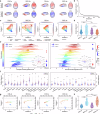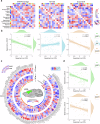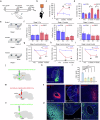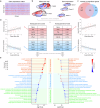Multi-connectomics underpin emotional dysfunction in mouse exposed to simulated space composite environment
- PMID: 41052978
- PMCID: PMC12500946
- DOI: 10.1038/s41398-025-03538-6
Multi-connectomics underpin emotional dysfunction in mouse exposed to simulated space composite environment
Abstract
Long-duration space exploration, including missions to the Moon and Mars, demands strategies to preserve astronauts' emotional well-being for optimal performance. This study combines behavioral phenotyping, multimodal MRI, in vivo calcium imaging, and brain-wide genomics to bridge macroscopic brain function with mesoscopic neural activity and microscopic genetic processes, providing a dynamic characterization of the mouse connectome under simulated spaceflight conditions. We observed a reduction in gray matter volume, particularly in the prefrontal cortex, with prolonged exposure. Simulated space composite environment (SSCE) disrupted multi-scale functional connectivity and altered the macro-organizational functional gradient, reversing the relationship between brain function and emotional behaviors. Neural activity in the medial prefrontal cortex demonstrated exposure-time-dependent changes across emotional tasks, while genetic analyses linked SSCE-induced alterations in functional profiles to synaptic function and ion channel activity. Our findings reveal how extreme environments impact emotional behaviors, brain networks, and neural activity, offering insights for interventions to maintain brain integrity during extended space missions.
© 2025. The Author(s).
Conflict of interest statement
Competing interests: The authors declare no competing interests. Ethics approval: All experiments on animal were conducted in accordance with the Declaration of Helsinkis. All animal experiments comply with the ARRIVE guidelines. All animal procedures involving animals were conducted in accordance with the approved protocol for the care and use of laboratory animals the Animal Care and Use Committee of Tianjin University (Animal license number: TJUE: 2023-105). All the authors compliance with all relevant ethical regulations.
Figures








References
-
- Amemiya S, Takao H, Hanaoka S, Ohtomo K. Global and structured waves of rs-fMRI signal identified as putative propagation of spontaneous neural activity. NeuroImage. 2016;133:331–40. - PubMed
-
- Raimondo L, Oliveira LAF, Heij J, Priovoulos N, Kundu P, Leoni RF, et al. Advances in resting state fMRI acquisitions for functional connectomics. NeuroImage. 2021;243:118503. - PubMed
MeSH terms
LinkOut - more resources
Full Text Sources
Miscellaneous

